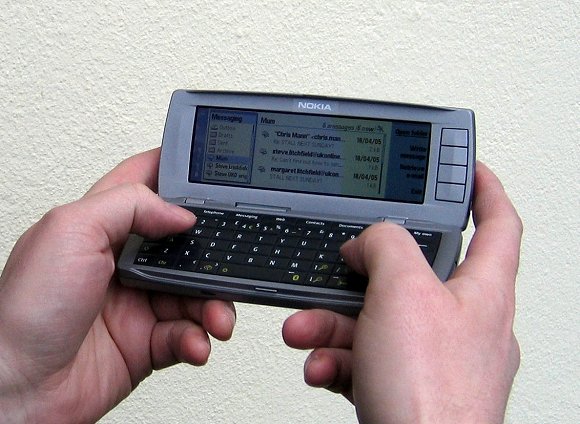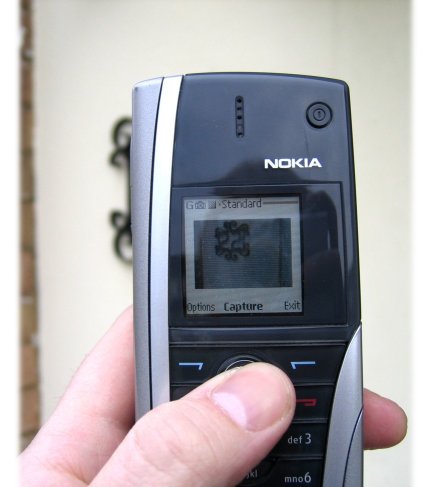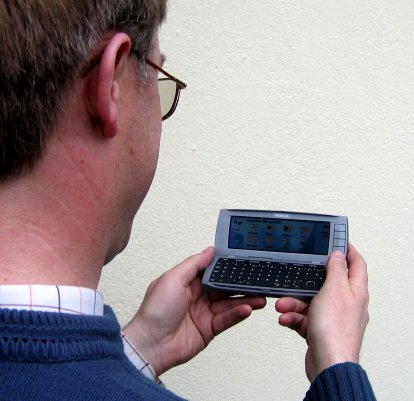Review: Long term test of the Nokia 9500 'Communicator'
Score:
84%
The Consummate Communicator
As with some of the top-end Pocket PCs released recently, calling the Nokia 9500 a PDA really is stretching the term to its limits. Rather, think of the 9500 as the old Psion 'everything you need' concept taken to its absolute extreme. Within the keyboard clamshell form factor, there’s (nearly) all the old Psion software plus the latest connectivity and multimedia technology, not to mention a large and bright 640 pixel wide screen and oodles of RAM and flash memory.
There’s still plenty of the old ‘Communicator’ (remember the 9210?) in here, especially in terms of software, with the 9500 still running Nokia’s Series 80, keyboard-driven interface on top of (the later) Symbian OS 7.0. Series 80 has been given a face lift (it's now officially at v2), but many of your old legacy 9210 favourites should still work happily, which will especially please companies with bespoke applications. In particular OPL programs will all run unchanged. The Communicator, is at heart, a serious device for serious people, and this is borne out in the software catalogue over the last four years.
The 9210 in turn, of course, was heavily based on the operating system and application suite inherited from Psion Software, which became part of Symbian. In practice this makes the 9500 a very good current-day match for any Psion owners finally giving up with 1990s palmtop hardware and looking for something more recent.
By omitting the external aerial and moving the speaker round to the ‘normal’ side, Nokia has managed to slim down the Communicator significantly, being 10mm shorter and 22g lighter (though note that the new 9300 is even smaller, albeit with some compromises). There's not much you can do on the cover phone, other than taking calls, reading text messages, looking up contacts and taking photos, but most of your time will be spent inside the clamshell anyway.
The 9500's display is quite a bit brighter than the 9210's, and sharper to boot. Even in bright sunlight the display is still readable, where the old 9210 one would be almost totally black.
The Communicator keyboard has been improved, with no gaps between each key, a more positive action and individual cursor keys (in addition to the navigator control). The only downside is the smaller size, reducing even good typists to using two fingers (or thumbs) and requiring fairly firm keypresses if you want to avoid missed letters. There’s also a ‘My Own’ button instead of ‘Extras’, which you can assign to an application of your choice, with all your utilities and third party applications now appearing in nested folders underneath the new, much more comprehensive ‘Desk’. This reorganisation makes a lot of sense, integrating favourite documents, notes and applications into one seamless hierarchy.

Quantum leaps
Memory was a huge problem on the 9210, and both RAM and internal flash disk space have taken a quantum leap, to 32MB and 80MB respectively. And with the standard applications now in ROM, most of that 80MB is yours to do what you like with, a veritable revelation for anyone used to making do with the paltry 4MB internal disk on the original 9210.
Some reviewers have commented on the 9500's slow processor and sluggish performance, but take these reports with a pinch of salt. Firstly, the processor is deliberately kept at 150MHz, in order to extend battery life, one of the most important parameters when actually using the Communicator. Secondly, these reviewers just don't know how to use a real multi-tasking computer - they keeping hitting all the 'Exit' buttons in applications. The whole point of Symbian OS is that applications can be left running and switched back to instantaneously! (Phew, it was good to get that off my chest). As with the Psion palmtops of old, it's very easy to keep over a dozen programs running at any one time, switching to them as needed either with the menu-based program list or using their original icons or shortcuts. The three second wait while an application is started for the first time is a minor inconvenience; used properly, having to wait for 9500 applications to start should be a rare thing.
 Connecting to the world
Connecting to the world
As befits any top-end smartphone these days, there’s now full support for Bluetooth, GPRS and EDGE wireless data, plus Wi-Fi for extra connectivity within the office (or at a ‘hot spot’). Although I haven't had 100% success rate with commercial hotspots (due to their often complex sign-up pages), it's very easy in most towns to simply move around until you're within range of someone's 'Open' Wi-Fi network and then piggy-back onto this using the 9500's 'Easy WLAN' system. I hadn't expected to make much use of Wi-Fi, not having it in the office, but whenever I'm waiting while out and about, it's great to spot the little 'W' icon in the status area and realise that I effectively have free wireless broadband to keep me interested.
The 9500’s Internet software is well specified, with the already good rebranded version of Opera coupled with super-fast Wi-Fi, and even including working (well, some of the time) Flash and Real content players. For sensible sites, designed by someone who knows what they are doing, the 9500's browser is superb. Sadly, so many sites these days seem filled with javascript and layout bloat and are never tested on dial-up connections or mobile GPRS users with standard VGA width screens. But that's a rant for another day... In the meantime, vote with your feet by avoiding such sites.
Messaging is a capable email system, much the same as on the 9210, and it's easy to stay in touch with your POP3 or IMAP4 mailboxes without incurring heavy GPRS costs. I found that setting messages to download if they were less than 5KB worked out perfectly, with most genuine emails fitting into this category and with viruses and large attachments being kept at bay. My own (freeware) Automail helps automate retrieval so that I never have to wait while email is collected. The biggest niggle is the speed of opening and closing messages, typically around two to three seconds (with firmware 5.22), which gets a little wearing.
There’s a standard VGA camera on the 9500’s rear, for taking spur of the moment snaps, although you can only take photos with the 9500 closed, using the outside display as the viewfinder. This arrangement is fairly logical and works well, although spoilt slightly by the wobbly cover phone navigator, meaning that you'll sometimes find yourself in the wrong camera mode. In addition to standard VGA snaps, the 9500's camera surprises by including a gimmicky 2X digital zoom, a thumbnail 'portrait' mode (just right for Contacts inclusion) and a working but ultra-pixellated 176 by 144 pixel video mode. Picture quality of standard VGA photos is better than those taken on my Sony Ericsson P900 (and a WHOLE lot better than those taken on the Treo 600 and other old Series 60 smartphones I've tried) and I've done some fairly respectable prints from 9500-taken photos.
It's no match for modern megapixel cameras though, consider the 9500's VGA capability as a convenience thing only. With some companies banning camera phones on security grounds, it's interesting to see the arrival this year of the camera-less 9300.
Capable software
Office compatibility has been boosted with Presentations, for editing existing Powerpoint slide shows and creating new ones. With a Bluetooth adapter for your projector, you can (in theory) even run a presentation from your Communicator. The 9210’s capable Word and Sheet applications are largely unchanged, although there are the usual concerns about some document structure and formatting being lost in a round-trip scenario from and to the desktop. Native (Symbian) Word and Sheet files are handled speedily, but on-device conversion to and from Microsoft Word and Excel can be quite slow. In addition, Word (now called 'Documents', for some reason) is missing its Spell Checker and Thesaurus, presumably due to licensing issues, a crying shame. In the initial firmware (4.44), there were some compatibility issues with Office under Windows Service Pack 2, but these are now sorted out.
There's no database in the software suite, which is a shame considering how useful Data was on the old Psion Series 3 and Series 5 palmtops, but at least Yellow have now come to the rescue with their YData.
File manager is unchanged and is in many ways one of the stars of the 9500 software suite. Just as on the old Psion (EPOC) palmtops, you can group files by theme in as simple or as complicated a folder hierarchy as you like. Essentially, any file can go anywhere. A recipe for potential disaster for newcomers but a tremendously welcome feature for anyone with 'power user' ambitions. Just as on a Psion, it's quite possible to run a mobile office from the Nokia 9500, handling projects and their associated documents with ease.
Calendar and Contacts are almost unchanged from the 9210 and are both very usable, with a few quibbles about font sizes used and the screen layout. Importantly, notes are now fully integrated into Calendar entries, so no more having to attach EPOC document files, as on the Psion and 9210. Although Calendar synchronisation worked fairly well in both Psion and 9210, it's now even more solid, thanks to the use of SyncML, and the new notes system doesn't feel quite so 'out on a limb'. Interestingly, the built-in To-do system can function both for traditional tasks and ad-hoc notes, in the same manner as Jotter on the Psion (though the Find function is well and truly bugged).
 Multimedia and extras
Multimedia and extras
Music Player is excellent and now supports MP3, WAV, RealAudio, MIDI and AAC file formats, although you’ll have to use the dedicated Nokia HDS-3 wired stereo headset to listen to these properly as there’s no standard headphone jack. Music tracks are queued up by folder, an elegant system that works well for me. The only downside of using the 9500 as your MP3 player is that there's currently no access to Music Player from the cover phone, so you have to open the clamshell to adjust volume or change albums/folders.
On the video side, RealPlayer can handle standard 176 by 144 pixel 3GP video files, produced by Nokia's own free Multimedia Converter 2.0. This is all well and good, although if you want to experiment with DVD and meatier video content you're better off with SmartMovie or Makayama's suite
Although the OPL programming language is still not built in, it's an easy and free addition and significantly enhances the 9500's use for mobile professionals. Need a tool? Why not create it to order? It's quite practical to create applications on the Communicator itself, as in the good ol' days of Psion, and it's great to tap away, developing in odd moments of downtime while out and about.
Other Extras which are supplied (in ROM or on CD or on the 9500 support web site) include a handy units converter, ZIP manager, Images (a basic picture browser and editor), Acrobat Reader, the Bounce puzzle game, a golf game and a selection of data conversion and synchronization tools.
Ghost of PsiWin almost banished
As the first post-PsiWin desktop suite from Symbian, PC Suite for the 9210 was a little flaky in places, with dodgy synchronisation and slow (115kbps) serial connection speeds. PC Suite for the 9500 benefits hugely from a proper 1Mbps (or thereabouts) USB interface and sync routines rewritten to use SyncML from the ground-up. Although a connection to your PC takes a few seconds to get properly established, it's very reliable after that. And, just as with PsiWin and the older Communicator PC Suite, there's the welcome ability to browse your handheld's raw files and folders (although not \System) from the comfort of Windows Explorer. The backup system now works well (make sure you've got the very latest PC Suite version!), although if you've got a large MMC (512MB or above) you'll want to stick to backing up the internal disk, handling the MMC separately in a dedicated card reader, purely for speed reasons!
Verdict
After a year of more or less day in, day out use, the 9500's still looking pretty good. The tensioner in the hinge which helps this to stay stiff snapped a couple of months ago, but the screen still stays where it's put and there are no other issues with the hardware. It's only been dropped once (the Covertec slide-in case, now discontinued, showing the weakness of its magnetic catches). Probably my biggest disappointment has been with the platform itself, with third party developers not flocking to Series 80 (despite its similarity to the well-supported Series 60) in the numbers we'd all hoped. Good games, in particular, are few and far between, but maybe this just reflects the business focus of Series 80 yet again.
The 9500 won't appeal to the typical smartphone user, it's true. It's too big and there's simply too much here to confuse the novice. For them, there are a wealth of Series 60 smartphones, some now with stereo audio and matching Bluetooth qwerty keyboard. And with a heck of a lot more games. But for the ex-Psioneer, for the professional on the move, for the OPL hobbyist, and indeed anyone else who fancies a real keyboard and serious applications, this is the consummate communicator.
Steve Litchfield, Oct 2005
(Review mirrored from 3-Lib)
Reviewed by Steve Litchfield at
